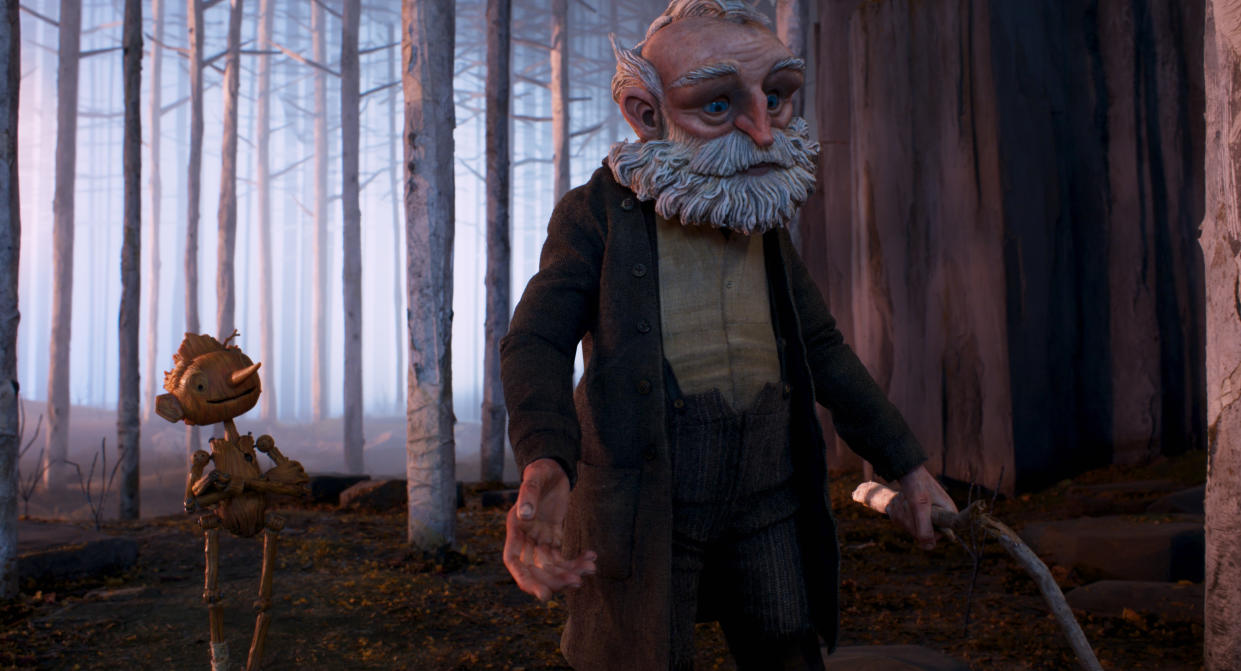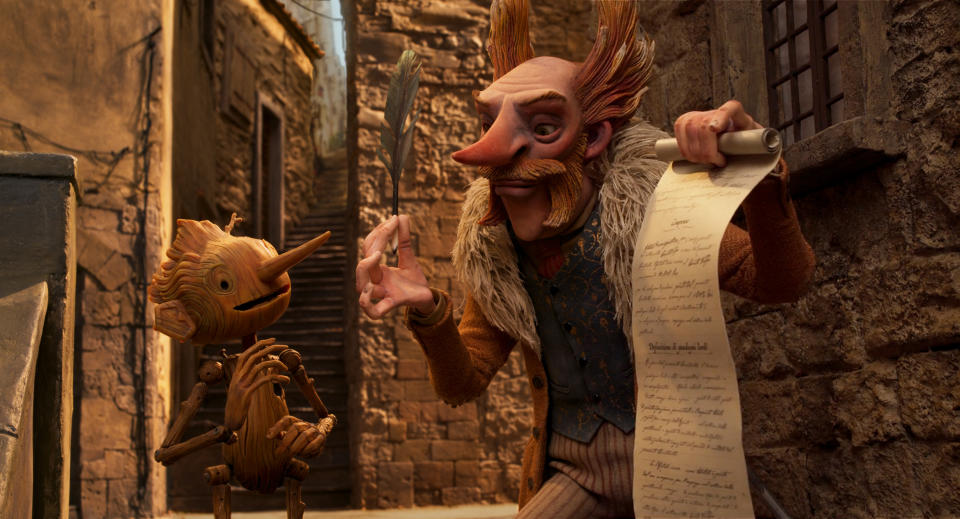Guillermo del Toro Walks Us Through the Oscar-Worthy Crafts of ‘Pinocchio’

- Oops!Something went wrong.Please try again later.
With Guillermo del Toro‘s stop-motion “Pinocchio” becoming Netflix’s greatest hope for a Best Picture Oscar nomination (in addition to its frontrunning Best Animated Feature status) there could be a spill-over into the craft races as well. That would be a historic breakthrough for the tactile, handmade technique, which, up until now, has only garnered a Sci-Tech Oscar (for Laika’s innovative 3D character animation printing system) and nominations in visual effects (for Laika’s “Kubo and the Two Strings” and Disney’s “The Nightmare Before Christmas”) and original score (for Alexandre Desplat’s work on Wes Anderson’s “Isle of Dogs” and “Fantastic Mr. Fox”).
But the exposure from del Toro’s masterful version of Carlo Collodi’s fable — which the Oscar-winning director of “The Shape of Water” recasts as a tale of rebellion set against the backdrop of Mussolini’s Fascist Italy — could finally point the Academy’s interest toward stop-motion achievements in production design, costume design, cinematography, sound, and original song. That’s important to del Toro, who endeavored to make “Pinocchio” like a live-action movie, by following the puppets with the camera and lighting the way he would actors.
More from IndieWire
'The Flying Sailor' Finds the Beauty in History's Most Devastating, Non-Nuclear Explosion
2023 Oscars: How 'Avatar: The Way of Water' Could Make a Big Splash in the Craft Races
“I think the beauty of stop-motion and why it has a very demanding and frail state as a production and storytelling method is that it [requires] basically the same rigor and delivery as a live-action film,” del Toro told IndieWire. “You are designing and physically building a set, you are aging the walls, and fabricating every prop. It needs to fit not only the world but the ‘hand-held actors.'”
Production Design
“Pinocchio” production designers Guy Davis (“The Shape of Water” concept designer) and Curt Enderle (“Isle of Dogs”) and art director Robert DeSue (“Kubo and the Two Strings”) opted for a handcrafted, Old World design that not only evoked Italy circa the 1930s, but also incorporated the look of wood to complement the title character (Gregory Mann), whose appearance here is inspired by Gris Grimly’s feral conception for a 2003 edition of “The Adventures of Pinocchio.” At the same time, they settled on warm gold and amber hues for the village setting, oranges and greens for the traveling carnival, red for the Fascist camp, and cool blues and purples for the underworld of Limbo. Many of the sets were constructed with removable walls or other access points to better enable the animators to reach and manipulate the puppets.
“As Ginger Rogers used to say, ‘I did everything Fred Astaire did, but I did it backwards and in high heels,'” said del Toro. “The same thing I can say about stop-motion. We have to execute the same level of precision, realism, but in miniature. We had to do multiple tests to simulate the carving of a piece of wood, and had to reproduce scuff marks and pay close attention to the coloring, staining, worn down areas.”

Netflix
Costume Design
Georgina Hayns, the legendary director of character fabrication and a veteran of Laika and Tim Burton productions, not only collaborated on the building of the puppets with England’s Mackinnon & Saunders, but also oversaw the costume design as well. Geppetto (David Bradley), the weathered woodcarver, is a gruff, salt of the earth type, who wears a simple woolen shirt, trousers, and sweater. By contrast, Count Volpe (Christoph Waltz), the sophisticated carnival conductor, resembles a fox, and looks much more flamboyant in his wool ensemble of beige shirt, brown tie, ornate green vest, stripped trousers and fur coat.
“We had to find fabric that simulates wool at full-scale and at monster-scale,” del Toro said. “The patterns, the texturing, the weaving needed to be scaled down; and we had to age that fabric. And one of the main things that is exquisite in stop-motion is when you lay that fabric over a puppet in such a way that animators know that when a wrinkle occurs in a shirt or in a pant, not only will it stay in that shape, but it will be analog and precise, as if it was a full-scale figure.”
Cinematography
Acclaimed cinematographer Frank Passingham (“Kubo and the Two Strings”) developed new techniques associated with live action for lighting stop-motion, which he termed “layered lighting.” This consisted of illuminating certain scenes in a hyperreal way for emotional impact, yet still within the overall naturalistic style. He also made sure that his light sources were visible within the frame, which is another live-action convention. The idea was to keep the light moving all the time. For example, during a church scene in flashback, Passingham casts Geppetto’s son, Carlo (also voiced by Mann), in an angelic light as he glances up at a wooden statue of a crucified Christ.
“It has to be done in layers,” added del Toro. “You have one frame exposure for the key light, one frame exposure for the fill light, one frame exposure for any moving light. And then you sandwich everything together, and the contrast needs to be preserved in that sandwich. And you have to move that light in synchronicity with a motion-control rig. The fact that a craft like that exists in cinematography and has gone unrecognized for decades of work is to me staggering.”
Visual Effects
Fire and water are important elements of “Pinocchio,” overseen by VFX supervisor Aaron Weintraub (“West Side Story,” “Pacific Rim”) of MPC Toronto. The greatest challenge with water was to create an environment that supported the tactile imperfections and whimsy of the stop-motion. The ocean had to drop into this world naturally, but still perform and interact like real water during the turbulent dogfish sequence. The basis for the ocean was a traditional dynamic water FX simulation that was then heavily post-processed to remove the lateral flow, essentially restricting it to be more static and rubbery when not interacting with a character or environment. Displacement and bump map textures were applied to create the sharp wave crests and a layer of foam was applied, designed to look like it was created from batches of tiny crystalline structures.
The digital approach to fire was always rooted in a practical stop-motion test done early in pre-production, which made it into the final film as the only practical stop-motion fire shot. This creative approach — whether the striking of a match or the bombing of a church — used panels of cheesecloth held in place by armature wire, creative lighting effects, and a homemade varnish filter on the lens to give it a warm, misty look. Rather than a typical digital pyro simulation, the fire was crafted to reproduce this practical approach, with simulated cheesecloth lit to look like fire and composited with glows and filters to blend it into the scenes.
Sound
The primary challenge for supervising sound editor Scott Martin Gershin (“Pacific Rim”) and Oscar-winning re-recording mixers Jon Taylor and Frank A. Montaño (“First Man,” “The Revenant,” “Birdman”) was creating a subtle use of sound from scratch that was suitable for stop-motion. “I told Scott we cannot design this film like a live-action movie,” said del Toro. “If the sound design is too realistic, then it is going to sound bigger than the images. We have to find the simplicity of a 10-track mix with your tracks. One of the things I was adamant about was you never lost the beautiful miniature proportion of the sets and the puppets. It was a streamlined approach, and I was surprised that he resisted overdoing it. It is the very best mix that I have ever had in my career.”
To sonically capture the physicality of Pinocchio, Gershin experimented with the sound of wood, working with PRS Guitars, which provided 50 pounds of guitar wood — including curly maple, Brazilian rosewood, and other exotic types. At a wood and metal shop in Taylor’s home, the team cut the wood down to pieces like a xylophone and tried out various bits of metal as well to recreate the rusty hinge-like squeaks for the nails in Pinocchio’s body. They followed the wooden boy’s emotional development through the use of Atmos, changing the tonality of the wood they used for him as the story progressed.
Score
In keeping with the theme of wood associated with Pinocchio, Alexandre Desplat’s haunting score exclusively relied on instruments made of wood, including piano, guitar, mandolin, marimba, flutes, and oboe. However, the composer found a loophole with the French horn, since in France it’s considered part of the woodwinds section.
“And with that limitation, we were paradoxically liberated,” del Toro added. “We found the sound of the movie within that group of instruments, and it adds a subtle layer in the compositions. And we made it thematic for every character and quoted it in unexpected moments of great terror and great tenderness. We also looked for themes that had the simplicity of a lullaby, which are not only hummable but have a primal emotion. I asked Alexandre to add a descending note to the Pinocchio theme to make it a little more colloquial and not so exquisite. He is not afraid of melody or grief and his use of guitar with Geppetto reminds me of “The Deer Hunter” theme.
Original Songs
This marks del Toro’s first musical, and his debut as a songwriter, contributing lyrics with Roeban Katz to accompany Desplat’s music. The first song, “My Son,” is a lyrical lullaby that Geppetto sings to Carlo. The Oscar-qualifying song, “Ciao Papa,” marks Pinocchio’s sad farewell to his father and becomes a much deeper ode to loss later in the film.
Del Toro told IndieWire that it was important for Mann to sing instead of a professional “because his fragile voice goes so well with the stop-motion.”
Best of IndieWire
Sign up for Indiewire's Newsletter. For the latest news, follow us on Facebook, Twitter, and Instagram.


